Jbl Harman 3-Way Studio Monitor 4312G User Manual
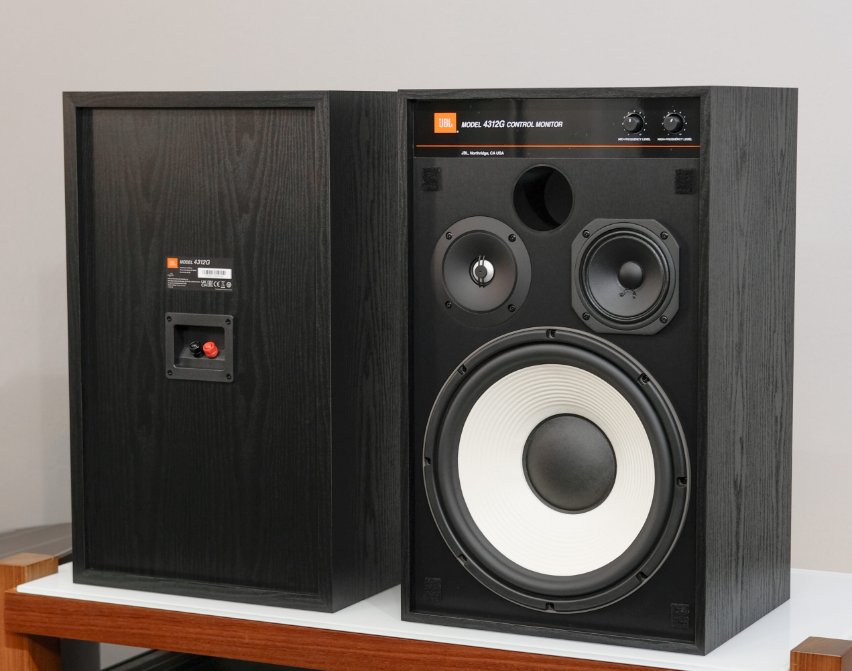
Content
Introduction
The JBL Harman 3-Way Studio Monitor 4312G is a high-performance compact speaker that embodies JBL's iconic design, dating back to 1968. Featuring a 12-inch woofer, a 5-inch mid-range driver, and a 1-inch tweeter, it delivers exceptional sound clarity across a wide frequency range of 44Hz to 40kHz. This studio monitor is engineered for both professional and home audio applications, ensuring accurate sound reproduction for discerning listeners. With its robust construction and elegant finish, the 4312G is perfect for any setting. Priced at approximately $3,500 CAD each, it represents a premium choice for serious audiophiles.
For more than 70 years, JBL has been providing audio equipment for concert halls, recording studios and movie theaters around the world and has become the trusted choice of leading recording artists and sound engineers. The 4312G honors that legacy with the iconic 12-inch (300mm) 3-way configuration that dates back to 1968 with the original Model 4310 Control Monitor. Utilizing a compact monitor-type footprint, the 4312G features advanced JBL transducers including the JW300SW-8 Pure Pulp cone woofer, the JM125PC-8 Polymer-coated Pure Pulp cone midrange, and the 054ALMg-1 Aluminum/Magnesium Alloy tweeter.
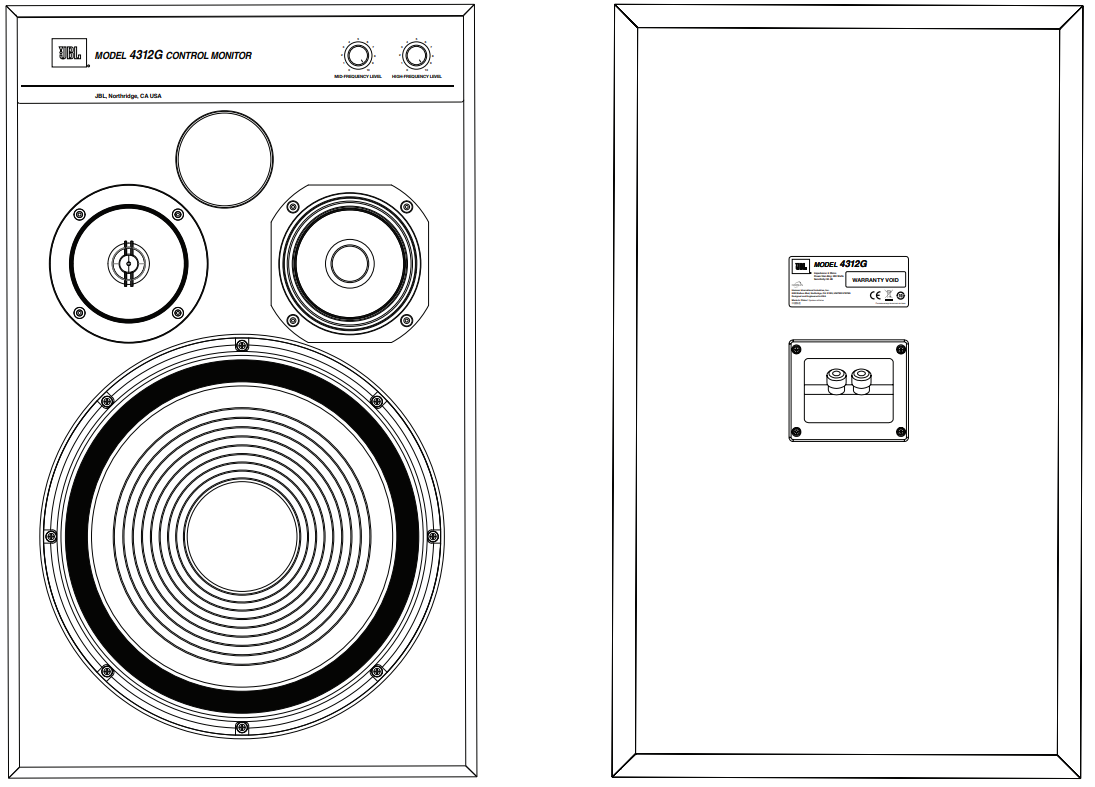
PACKAGE CONTENTS
JBL 4312G loudspeakers are sold in mirror-image matched pairs. The outer carton serves to protect two internal cartons each containing a single loudspeaker with a removable grille.
PLACEMENT AND POSITIONING
CAUTION: The 4312G weighs 55.5 lb. (25.2 kg) each. Before placing the speaker on a shelf or platform, be sure that it is sturdy enough to support the speaker’s weight.
Before deciding where to place your speakers, survey your room and think about placement, using the illustration below as a guide.
- Avoid placing the speakers near power amplifiers, heat registers or other objects that generate large amounts of heat.
- Do not place the speakers in very humid or dusty places.
- Do not place the speakers in direct sunlight or where they will be exposed to other strong light.
- For best results, place the speakers 6–8 feet (1.8-2.4m) apart. If you place the speakers farther apart than this, angle them toward the listening position.
- The speakers will produce the most accurate stereo soundstage when the angle between the listener and the speakers is between 40 and 60 degrees.
- Position each speaker so that its tweeter is approximately at ear level.
- Generally, bass output will increase as the speaker is moved closer to a wall or corner. For best performance, we recommend that you place the speakers at least 20 inches (50cm) away from the side walls.
- The 4312G may be stand mounted with the optional JBL metal stands (model JBL JS-120, sold separately) that angle the speaker upward.

LEFT AND RIGHT PLACEMENT
- The JBL 4312G is sold as mirror-image pair of loudspeakers with one having the tweeter on the left side and the other having the tweeter on the right side, yet neither one is marked or defined as a “LEFT” or “RIGHT” channel loudspeaker. Which one should be used for the left channel and which one should be used for the right channel will depend on a combination of factors including the listening distance from the speakers, the width of the room, acoustic reflectivity of the room, and horizontal versus vertical positioning of the loudspeaker.
- It is typically best to position the loudspeakers to create a triangle of three equal sides when measuring the distances between the tweeters in each speaker and the distance from the listener to each tweeter. In smaller rooms or instances where the listening position is relatively close to the loudspeakers, this will usually result in the tweeters being positioned to the inside of the listening triangle. This positioning can also be desirable in a more acoustically reflective room or when the speakers are placed on a shelf or close to a side wall.
HORIZONTAL ORIENTATION:

VERTICAL ORIENTATION:

In larger rooms or instances where the listening position is relatively further away from the loudspeakers, this will usually result in the tweeters being positioned to the outside of the listening triangle. This positioning will result in a wider soundstage but may require slightly greater “toe-in” for the left and right channel speakers in order to maintain proper center imaging. This positioning can also be desirable in a more acoustically absorptive room or when the speakers are placed along the long wall of a rectangular dimension room.
HORIZONTAL ORIENTATION:

VERTICAL ORIENTATION:
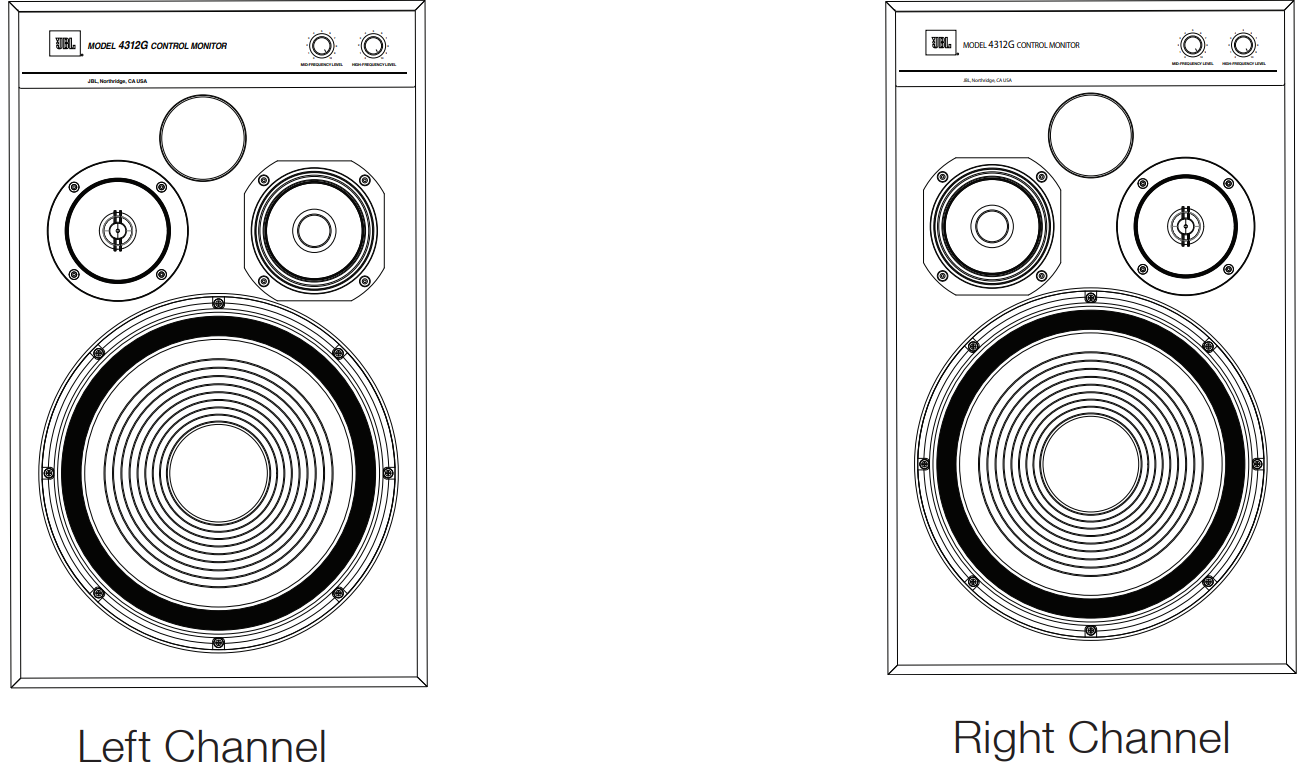
SPECIFICATIONS
- System Type 3-way Bass-reflex Monitor
- Woofer 12-inch (300mm) Pure Pulp cone (JW300SW-8)
- Midrange 5-inch (125mm) Polymer-coated, Pure Pulp cone (Model JM125PC-8)
- Tweeter 1-inch (25 mm) Magnesium/Aluminum Alloy dome (054ALMg-1)
- Impedance 6 ohms
- Recommended Amplifier Power 10-200 Watts RMS
- Sensitivity (2.83V/1m) 90dB
- Frequency Response 44Hz-40kHz (-6dB)
- Crossover Frequencies 640Hz, 5kHz
- Controls Attenuators for MF and HF Drivers
- Connector Type Five-way Binding Posts
- Finish Black Woodgrain with Black Grille
- Dimensions (H x W x D) 23 1/2" x 14-1/4" x 12" (597mm x 362mm x 305mm)
- Weight 52.4lbs (23.8kg) each
Description
The JBL Harman 4312G is built with durability and performance in mind. Its cabinet is constructed from high-quality wood and features a sealed front-firing port that helps in enhancing bass response without compromising on clarity. The monitor's three-way design ensures that each frequency range is handled by a dedicated driver, resulting in a balanced and detailed sound output.
The titanium compression driver handles high frequencies with precision, while the 5-inch midrange driver ensures clear and detailed midrange reproduction. The 12-inch woofer provides deep and accurate bass response, making this monitor suitable for a wide range of audio applications.
CONNECTIONS
CAUTION: Make sure that all of the system’s electrical components are turned OFF (and preferably unplugged from their AC outlets) before making any connections.
Speakers and amplifiers have corresponding positive and negative (“+” and “–”) connection terminals. The 4312G has color-coded connection terminals. The “+” terminal is red, while the “–” terminal is black. See the illustration on the right.
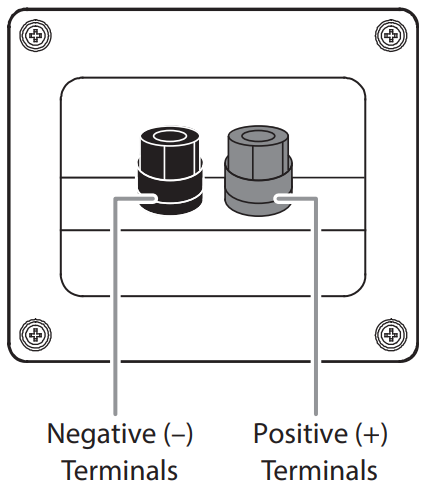
- The 4312G is designed so that a positive voltage at the “+” (red) terminal will cause the speaker drivers to move outward (toward the room).
- We recommend using a high-quality speaker cable with polarity coding. The side of the cable with a ridge or other coding is usually considered positive polarity (“+”).
- To ensure proper polarity, connect each “+” terminal on the back of the amplifier or receiver to the respective “+” (red) terminal on each speaker. Connect the “–” (black) terminals in a similar way. See your receiver or amplifier’s owner’s manual to confirm its connection procedures.
BASIC SINGLE-WIRE CONNECTION
Connect the amplifier to each speaker as shown in the illustration on the right.
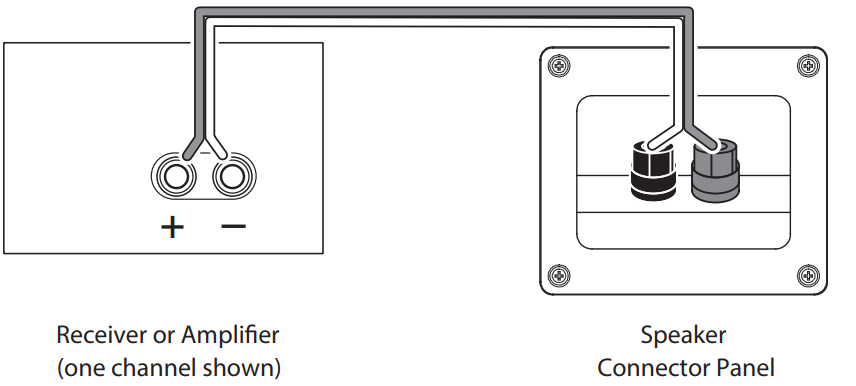
IMPORTANT: Do not reverse polarities (i.e., “+” to “–” or “–” to “+”) when making connections. Doing so will cause poor stereo imaging and diminished bass performance. The 4312G’s gold-plated speaker terminals can accept a variety of wire connector types: bare wire, spade connectors, pin connectors and banana connectors.
USING BARE WIRE OR PIN CONNECTORS
IMPORTANT: Make sure that the (+) and (–) wires or pins do not touch each other or the other terminal. Touching wires can cause a short circuit that can damage your receiver or amplifier.

USING SPADE CONNECTORS
IMPORTANT: Make sure the (+) and (–) spade connector blades do not touch each other or the other terminal. Touching blades can cause a short circuit that can damage your receiver or amplifier.
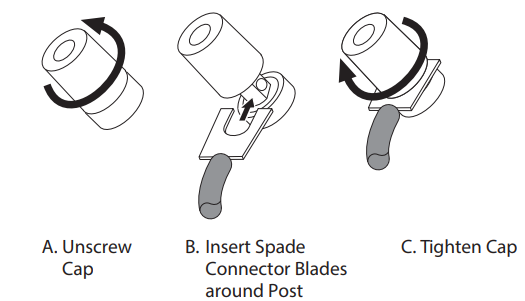
USING BANANA CONNECTORS

CONTROLS/ADJUSTMENTS
The 4312G has front-panel adjustments that let you balance the levels of the midrange driver (MF) and tweeter (HF) relative to the woofer.
You can use these controls to adjust the speaker’s sound according to your room’s acoustics, or your personal taste. The “center” default position is with the marks on the knobs pointing towards the number five.
As with most speakers, after you start playing the 4312G it will take the drivers’ suspensions several weeks to “break in” and achieve optimum performance. During this period, the balance between the woofer, midrange and tweeter may change, so we recommend that you adjust the midrange and tweeter controls accordingly.
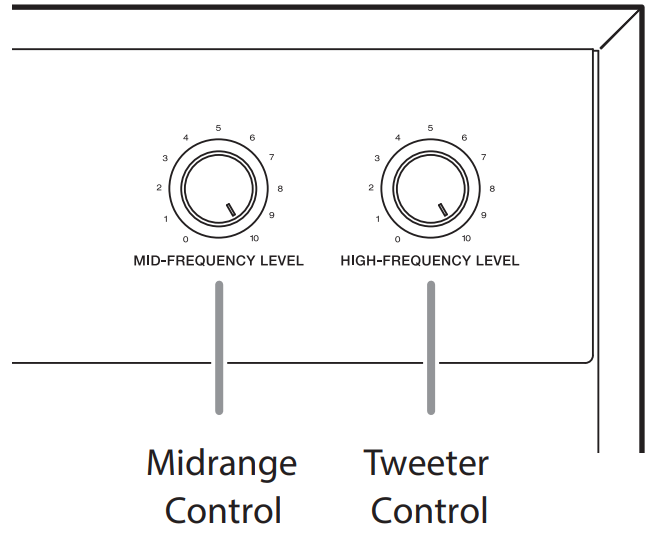
NOTE: There is a protective plastic film on the front control panel label. This may be removed upon installation.
Setup Guide
To set up the JBL Harman 4312G,
- Begin by placing the monitors in an optimal listening position, Typically at ear level and angled towards the listener. Ensure that the rear of the monitor is at least 12 inches away from any wall to avoid bass resonance issues.
- Connect your audio source to the monitor using XLR or 1/4-inch TRS connectors.
- Power on the monitor and adjust the volume to a comfortable level. For accurate sound reproduction, it is recommended to calibrate the monitors using room correction software or acoustic treatment in the studio.
- Finally, configure your monitoring settings according to your specific needs, such as setting up subwoofer integration if necessary.
CARING FOR YOUR SPEAKERS
- Wipe the cabinet with a clean, dry cloth to remove dust. Damp cloths or cleaning paper may dull the cabinet’s finish.
- Do not use volatile liquids such as benzene, paint thinner, alcohol, etc., on the cabinet. Do not spray insecticide near the cabinet.
- To remove dust from the grille fabric, use a vacuum cleaner set to low suction.
- Do not wash the grille in water, as this may fade the color or make it uneven.
- If the surfaces of the woofer and midrange cones become dusty, you can carefully sweep them clean with a soft, dry calligraphy brush or paint brush. Do not use a damp cloth.
- NEVER touch anything to the tweeter dome.
JBL - Harman 3-Way Studio Monitor 4312G Troubleshooting
No Sound Output
- Check Connections: Ensure the speaker cables are securely connected to the appropriate terminals on both the speaker and the amplifier/receiver.
- Source Selection: Verify that the correct audio source is selected on your receiver/amplifier.
- Test with Another Source: Connect a different audio source to check if the issue persists, as the problem may lie in the original source.
Distorted Sound or Crackling
- Check for Damage: Examine the speaker cone and tweeter for visible damage. Replace any damaged parts.
- Cable Quality: Use high-quality speaker cables and check for any fraying or breaks.
- Volume Levels: Avoid overloading the speakers by keeping the amplifier’s volume at a moderate level. Pushing the amp to its maximum output can cause distortion.
Pros & Cons
Pros:
- High-Quality Sound Reproduction: The 4312G delivers accurate and detailed sound output across all frequency ranges.
- Durable Construction: Built with high-quality materials, this monitor is designed to withstand demanding studio environments.
- Robust Power Handling: With up to 300 watts of power handling, it can handle high volume levels without distortion.
- Versatile Connectivity: Offers multiple connectivity options including XLR and 1/4-inch TRS connectors.
Cons:
- Cost: The JBL Harman 4312G is a professional-grade monitor with a corresponding price tag, making it less accessible to hobbyists.
- Size and Weight: Due to its robust construction and large drivers, this monitor is bulky and heavy.
- No Built-In Room Correction: Requires additional equipment or software for room correction which may add extra cost.
Customer Reviews
Customers praise the JBL - Harman 3-Way Studio Monitor 4312G for its clear and accurate sound reproduction. Many professional engineers appreciate its ability to reveal subtle details in audio mixes that other monitors might miss. However, some users have noted that the monitor can be quite large and heavy, making it less ideal for smaller studios or home setups.
Faqs
What is the frequency response of the JBL Harman?
How much power can the JBL handle?
What types of connectors does the JBL - Harman 3-Way Studio Monitor 4312G use?
Why is it important to position the monitor correctly?
How do I troubleshoot distortion in my JBL - Harman 3-Way Studio Monitor 4312G?
Is room correction necessary for optimal sound quality?
Can I use the JBL Harman 4312G in a home studio setup?
How durable is the JBL Harman?
What are some common issues users face with this JBL - Harman 3-Way Studio Monitor 4312G?
Is there a warranty available for the JBL?
Leave a Comment
